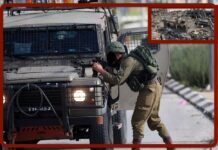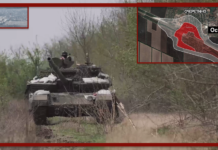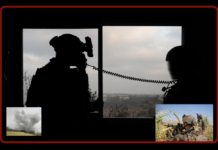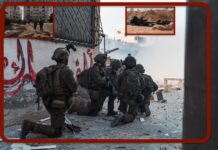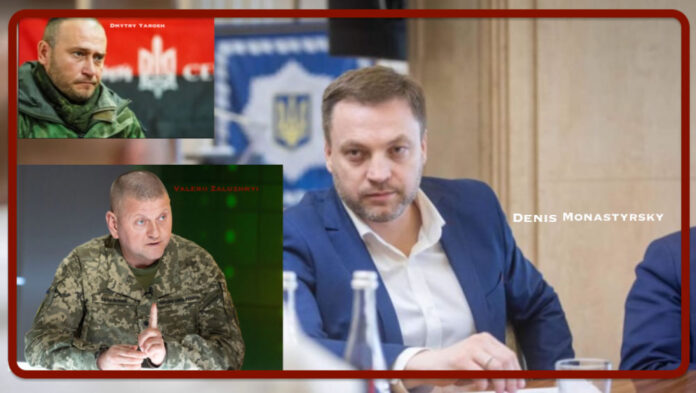
Decisions to militarise Ukraine in defence of a possible Russian attack after 2014 never quite subsided but suddenly became a reality between July 2021 and the end of the year in correspondence with the publication and issuance of the Presidential Decree of the Russian Federation, No. 400: National Security Strategy of the Russian Federation of 2 July 2021. And again the closure of the investigation in Ukraine against Hunter Biden which we will tell you about in another article. Well before then the Russian attack of 24 February 2022.
There are many reports in the social sphere announcing an increase in the number of military exercises from July 2021 and the use of newly purchased weapons such as Turkish BT2 drones and American Javellin anti-tank systems in occupied areas. The Ukrainian military speak of tests carried out in the areas of the occupied territories, and the OSCE and the Donbass authorities claim that civilian and military targets have been hit.
Taking a step back, we can see that from the end of mid-July 2021, the incumbent president, Volodymyr Oleksandrovyč Zelens’kyj, inaugurated a waltz of posts in the Ukrainian Armed Forces. This turnaround came about on 16 July when Denis Monastyrsky became the new head of Ukraine’s Ministry of Internal Affairs. The decision was supported by 271 deputies with the required minimum of 226 votes; Shaptala Sergey Aleksandrovich was appointed Chief of Staff on 28 July and the day before, on 27 July, Valeriy Zaluzhny was appointed Commander-in-Chief of the Ukrainian Armed Forces after President Zelenskiy dismissed Ruslan Khomchak from his post as Commander-in-Chief of the Armed Forces.
The dismissal comes according to presidential spokesman Serhiy Nikiforov after an effort to stem infighting between the Ukrainian armed forces and the defence ministry. “Volodymyr Zelenskiy has no doubts about the patriotism, loyalty to his oath of office and professionalism of Ruslan Khomchak,” Nikiforov reported. “But the president wants to see a synergy between the Ministry of Defence and the Ukrainian armed forces. Unfortunately, we do not see such synergy. We see, on the contrary, conflicts.”
At the time, Zelenskiy urged NATO to issue a clear “Yes” or “No” on a detailed plan for Ukraine’s accession to the transatlantic alliance. While Moscow described Ukraine’s accession to NATO as ‘a red line’. At the same time, US President Joe Biden’s administration announced that Zelenskiy would visit Washington on 30 August, when Congress was in recess for the summer.
The Ministry of Defence therefore from July 2021 dictates Zelenskyj’s political-military agenda and calls to command those men who participated in the ranks of the 2014 Maidan revolution and had fought against Russia. The beginnings are not rosy, especially in the presence of the Ukrainian electorate that includes yes Ukrainian nationalists, and Ukrainians, but also pro-Russian and Russian extremists. Within a few weeks Valeriy Zaluzhny called to work on his staff, Dmitry Yarosh, a friend of his and of the then Deputy Prime Minister and current Minister for Defence, Oleksij Reznikov, Yarosh was the leader of the Right Sector, the main commander of the Ukrainian volunteer army. The announcement of Yarosh’s appointment threw parliament into disarray.
On 2 November 2021, Yarosh declared on his social media that he had been appointed as an advisor to the Commander-in-Chief of the Ukrainian Armed Forces, Valerii Zaluzhnyi. In response to a request (December 2021) from Ukrayinska Pravda, the General Staff of the Ukrainian Armed Forces refused to reveal the details of its alleged cooperation with Yarosh citing the confidentiality of the requested information. A few days later, the defence minister himself announced the suspension of Yarosh from his post.
Yarosh is not an easy character to digest even in the upper echelons of Ukrainian politics. On 25 July 2015, at the request of the Russian authorities, Interpol placed Yarosh on its list of international wanted persons for incitement to hatred and acts of terrorism. As of 2 January 2016, he was no longer on Interpol’s lists.
In the aftermath of the collapse of the Yanukovich regime, Yarosh asked to be appointed deputy prime minister for law enforcement affairs, but his request was rejected; he was offered instead a position as deputy secretary of the National Security and Defence Council of Ukraine, but Yarosh refused this position as it fell short of his expectations. According to Ukrainian media there were discussions about Yarosh’s appointment as deputy head of Ukraine’s security service, but these discussions quickly fizzled out for unknown reasons. On 20 April 2014, Dmytry Yarosh claims to have received orders from Acting President Oleksandr Turchinov to lead 20 members of the Right Sector to sabotage a rebel-controlled TV tower in Sloviansk, causing the first combat casualties in the siege of Sloviansk. Yarosh denied his role in these events until two years later.
During the second battle of the Donetsk airport, Yarosh was injured on 21 January 2015 by the explosion of a Grad rocket in the nearby village of Pisky. He was evacuated out of the conflict zone. In early April 2015, the Ukrainian Ministry of Defence announced that MP Dmytry Yarosh would become an assistant to military chief Viktor Muzhenko and that his Right Sector fighting group would be integrated into the Ukrainian Armed Forces.
In February 2016 Yarosh started a new organisation called the Governmental Initiative of Yarosh (DIYA) into which 20% of Right Sector members had converged. In 2019 he supported the candidacy of Ruslan Koshulynskyi arch-enemy Yanukovich who was also present in the 2013 – 2014 demonstrations. In the Ukrainian parliamentary elections of 2019 DIYA joined in a united party list with the Svoboda parties, ultranationalist party, Right Sector and National Corps. Yarosh himself placed third on the party list. But in the elections they did not get enough votes to pass the 5% threshold, so the party did not win a single parliamentary seat in a single constituency.
Returning to another character of the turn of the century, we come to the Commander of the Zaluzhny Armed Forces Valery Fëdorovich, born on 8 July 1973 in Novograd-Volynsky, in the Zhytomyr region. In 1989 he graduated from high school and entered the Novograd-Volynsk Engineering College, graduating in 1993 with honours. After graduation, he studied at the Odessa Higher United Command School. Subsequently, Zaluzhny went through all phases of military service, not serving in the Soviet Union. Subsequently, he joined the combined arms faculty of the Odessa Institute of Land Forces. In 2007, he graduated from the National Defence Academy of Ukraine with a gold medal and was appointed Chief of Staff, First Deputy Commander of the 24th Separate Mechanised Brigade in Yavoriv, Lviv Region. In December 2020, he successfully completed the master’s programme at the National University “Ostroh Academy”, speciality “International Relations.
On 13 October 2009 Zaluzhny was appointed commander of the 51st Separate Mechanised Brigade Volyn, a position he held until 2012. Since 2014 he has been actively participating in the Russian-Ukrainian war. During the period when Zaluzhny led the JFO headquarters, Ukrainian troops liberated the village of Yuzhnoye (Donetsk region) and also moved into the Volnovakha region. Fighters who worked with Zaluzhny speak highly of him. General Zaluzhny often appeared on the front line in the JFO area without an entourage, accompanied by only one officer. In combat, he received his general’s epaulettes in 2017. Officers of the 79th Brigade and the 503rd Marine Battalion speak of General Zaluzhny as “a good and intelligent commander”. In 2017 Valeriy Zaluzhny became Chief of Staff, First Deputy Commander of the Western Operational Command of the Ground Forces of the Ukrainian Armed Forces and in 2018, Head of the Joint Operational Headquarters of the Ukrainian Armed Forces, First Deputy Commander of the United Forces. He is a member of the National Security and Defence Council (since 28 July 2021).
As a representative of senior Ukrainian officers and a participant in the hostilities in the Donbass, who did not serve in the USSR, – Ukrainian media write – he has a positive attitude towards the renewal of personnel by young people and the abandonment of Soviet practices. Regarding his priorities as commander-in-chief, Valery Zaluzhny said: “The general course towards reform of the Ukrainian armed forces according to NATO standards remains irreversible. And the key here is principles. Changes must take place, first of all, in the worldview and attitude to people.”
His detractors say that Zaluzhny has a fairly simple opinion: if the brigade commander is not ready to use cannon artillery at brigade level and take responsibility for his actions, then ‘It is not bad to have a snack, to start and organise local wars. And then run to the chief saying save me, help me.”
As soon as he took office, he initiated a series of tactical exercises: ‘Rapid Trident-2021’ in the Lviv region of Ukraine. During the manoeuvres, involving 6,000 military personnel from 15 partner countries, tactical exercises of the multinational live-fire battalion were conducted. As commander of the Ukrainian Armed Forces, Valery Zaluzhny, stated on 21 September 2021: ‘Rapid Trident-2021 is just one part of a wider series of activities within the Joint Efforts-2021 project. In my view, these manoeuvres are a response to Moscow and Minsk’s Zapad-2021 exercises, as well as possible large-scale invasion threats from Russia”.
Military personnel from the United States, Great Britain, Canada, Jordan and Sweden were present during the exercises. Eastern Europe was represented by Poland, Slovakia, Romania and Hungary. Among the closest allies were the young democracies of the Baltic States, Georgia and Moldova.
On 22 September during the exercises, Zaluzhny stated that “the exercises aim to increase Ukraine’s defence capabilities to curb armed aggression”. The videos show the Ukrainian army’s manoeuvres in the regions bordering Russia – Chernihiv and Sumy. Zaluzhny also stated on 27 September: ‘Ukraine is ready to join, not ready for NATO, Ukraine’s entry into NATO depends on the Alliance’. During an interview, he let it be known that the Ukrainian army had already implemented all NATO standards and apparently would not do anything else: ‘In my opinion, a political decision is needed to become NATO’.
At the same time, the Ukrainian military chief is not at all embarrassed by the reluctance of Western states to accept Ukraine into the Alliance.
Then, on 29 September 2021, Zaluzhny issued a directive allowing the military in the combat zone in the Donbass to return fire on the enemy without the consent of the highest political-military leadership; in fact, he left the field open for local commanders to use all available weapons. Moreover, on his orders, the military was relieved of the need to compile all documentation deemed unnecessary.
On this occasion, Zaluzhny said that the Bayraktar attack drones ‘have been taken out of storage’ and are already carrying out combat missions. The news immediately made the rounds in Ukraine, not least because this act would undermine the Minsk agreements once and for all.
The fact that Turkish drones were at work was proved by the radars that recorded the flight of a drone over Volnovakha, Kurakhovo and Krasnoarmeyskoye on 29 September. On the same day, in a TV interview, Zaluzhny stated that ‘Russian troops should be expelled, because there is Ukrainian land and the Ukrainian people will not tolerate it! As commander-in-chief of the Ukrainian armed forces, I say to you: there are no prohibitions! Commanders must use all available forces and means, methods at their disposal to save the life and health of their subordinates’.
Kiev initially refused to refute the words of the commander-in-chief of the Ukrainian armed forces on the bombing of the Donbass. For the separatists, this order amounted to Ukraine’s withdrawal from the agreements on an indefinite truce of 22 July 2020, Russia’s permanent representative at the Donbas talks Boris Gryzlov said.
OSCE observers in those days recorded new trenches and mortar positions of Ukrainian security forces in the neutral zone. Once again calming the waters during a meeting of the Contact Group was the head of the Ukrainian delegation and Deputy Prime Minister Oleksiy Reznikov, who, commenting on the statement of Commander-in-Chief Valery Zaluzhny on the lifting of all restrictions on return fire, recommended not paying attention to the bloggers’ statements, and assured that Ukraine was fulfilling everything and that there were no orders to cancel obligations. Only one fact contradicted him: the statement was made on video by Commander Zaluzhny himself.
At that time, the representatives of the LPR and DPR responded to him, and at the same meeting of the Contact Group they asked, through the voice of the LPR Foreign Minister Vladislav Deinego, the Commander-in-Chief of the Ukrainian Armed Forces Valery Zaluzhny to withdraw his statement on the possibility of opening “return fire” and the use of attack UAVs by the Kiev Security Forces without an order from the high command. The retraction never came.
On five October, Commander Zaluzhny approved methodological recommendations on the use of social networks for official pages and personal accounts of the military. The text of the recommendations was published by the Ukrainian army. In particular, it is recommended to stop using the mailboxes of social networks VKontakte, Odnoklassniki, Telegram messenger, Mail.ru, yandex.ru. In its communications it stated: ‘Direct access to the social services database with extraordinary ease allows Russian special services to identify a wide range of information that ordinary citizens and military personnel upload to social networks’.
Still on October 6, the Zaluzhny directive authorising the bombing of the Donbass was discussed in the Donbass: “Ukraine’s military leaders have opened a Pandora’s box, which will result in the withdrawal of the Donbass to Russia”. “The Ukrainian armed forces have been authorised to fire on the inhabitants of the Donbass without Kiev’s consent,” said the commander of the joint forces operation Oleksandr Pavlyuk, Lenta.ru reports.
Former Verkhovna Rada deputy Oleksiy Zhuravko told Narodnye Novosti in an interview how Kiev’s uncontrolled aggression in south-eastern Ukraine will end: ‘Despite the formal ceasefire regime in the Donbass, the Ukrainian armed forces continue to regularly bombard the republics’ settlements. According to Pavlyuk, there is no need to obtain permission to fire if necessary. Commanders on the ground make their own decisions. Earlier, a similar statement was made by the head of the Ukrainian armed forces Valery Zaluzhny. In addition, Zaluzhny signed a special directive that effectively legalises the opening of fire on civilians…’.
On 16 October another statement by the commander-in-chief of the Ukrainian armed forces Valery Zaluzhny left the Joint Forces Committee for the Donbass appalled: he said he was confident that the ‘Cossack and rebel blood’ would help restore the country’s sovereignty.
Graziella Giangiulio


